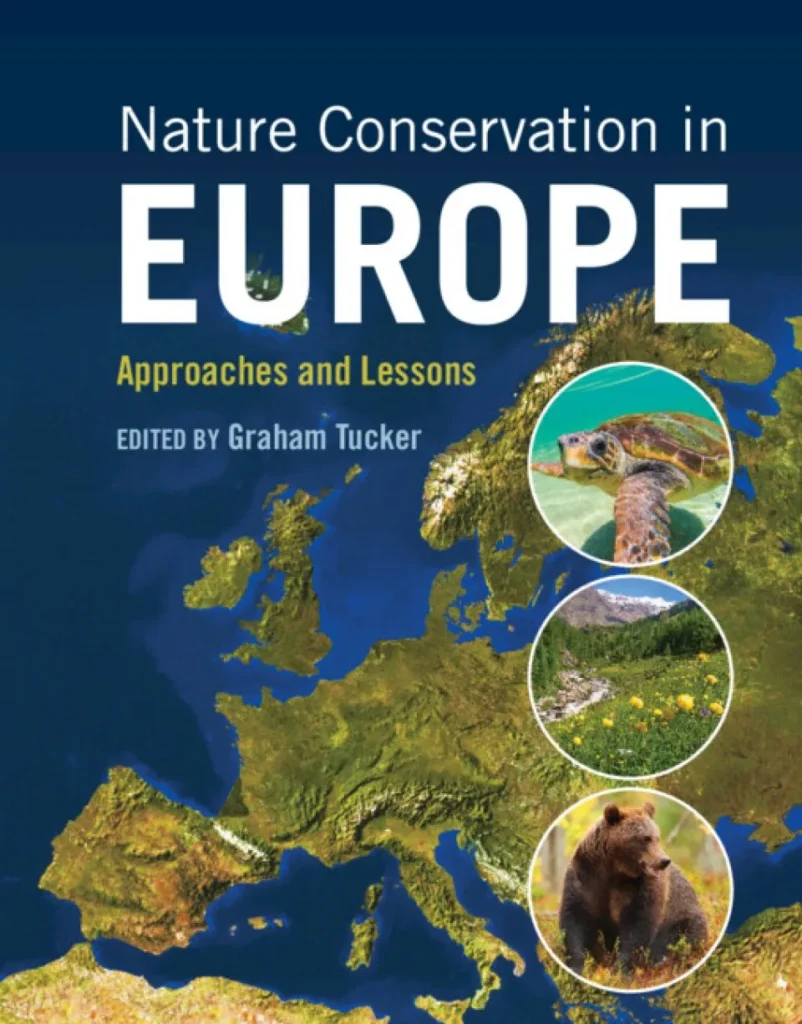Nature Conservation in Europe – Approaches and Lessons
Edited by Graham tucker

The book seeks to describe, quantify and critically analyse the nature conservation approaches and practical actions that have taken place across Europe, especially in the EU and UK, over the last 40 or so years, and to identify lessons.
Despite its scale it is very readable and manages to explain even the more obscure corners of EU legislation in a simple and comprehensible way. I can see it being useful as a text book or reference book but I think it will be of more general interest to anyone interested in the progress of nature conservation in Europe and wondering what happened and why. It also seeks to identify why, despite many words and good intentions, biodiversity across Europe continues to decline. It is in no sense however a polemic, but seeks to gather, analyse and assess the available information before offering conclusions and lessons learned.
The first chapters take a Europe wide perspective, describing the key characteristics of Europe’s environment and nature and the international drivers for nature protection. Chapter four considers the legal measures employed in the EU that have sought to implement the policy objectives, and chapter five consider lessons learnt and future implications.
Chapter five considers conclusions, lessons learnt and implications. As in the previous chapters there are some excellent tables that summarise a range of comparative data and information. The overall conclusions about the causes of continuing biodiversity decline are not surprising with the main culprit identified as agricultural intensification and abandonment of some traditional, more biodiversity friendly farming methods. Other reasons are identified as increased urbanisation, particularly in Eastern Europe, with significant infrastructure development, often to support increased tourism, together with intensification of both forestry and fishery methods. Behind these lie the twin challenges of funding and lack of political will.
Probably wisely, the book avoids getting too drawn in to discussing the political shenanigans that lay behind delays in implementation of the European Nature Directives and that continue to this day. It identifies inevitably that ‘legislation is not enough’ but requires guidance, funding and monitoring while success is most likely where there is scientific, public and political support. On balance, however, it comes down in favour of strong legislation, and strict implementation, lamenting somewhat the more ‘softly, softly’ approach of the European Commission in recent years, and it calls for some stronger measures for example to provide legal force to the EU’s ‘no net biodiversity loss policy. It doesn’t have much to say about how to manage the conflict that has often arisen between strict implementation and public support – although some of the later country specific chapters do so. But it does identify where some approaches to implementation have exacerbated problems and increased conflict. More examples of successes would be welcome – hopefully they exist!
The remaining 26 chapters are devoted to the experiences in individual countries, comprising 24 EU nations plus the UK. The editor has been commendably successful in securing an impressive array of experience and expertise to write these sections. In particular it’s good to see the inclusion of authors who are former employees of implementing authorities as well as academics and NGO experts.
The national accounts are, without detracting from the overview, the real strength and interest of the book adding detail and colour to the summary sections. Inevitably there is greater variety of style and focus but all cover the same essential main aspects: the main natural features and habitats of the country, the history of land change, drivers of change and current status, legal measures and structures (e.g. protected area network), and funding.
Generalising about these chapters is not really possible, but there is no doubt that while enacting legislation to protect nature didn’t start with EU Nature Directives they, and other EU environmental legislation, have had a huge and extensive impact across the continent on how nature conservation is viewed and implemented. General patterns of biodiversity loss due to intensification of various kinds of land use at the expense of semi-natural habitats are universal, together with the loss of low impact agricultural systems.
Equally universal seems to be the extent of changes and restructuring of the relevant national implementing authorities. For example , what is now the French Ministry of Ecological Transition has undergone 21 changes of name in 50 Years. Institutional complexity, lack of knowledge and skills and of course lack of funds crop up repeatedly in these chapters but there is also inspiration to be found in the efforts and commitment of many involved and progress towards political mainstreaming and public awareness of the biodiversity crisis and the steps needed to tackle it.
Overall then a fascinating, comprehensive and thought provoking account of nature conservation in Europe over 40 years that has been curated with care. In focusing primarily on facts rather than opinion it provides the raw material for further analysis and debate. It’s the sort of book that I searched in vain for twenty years ago and am pleased to see that it is here, at last.
Reviewed by Ian Jardine
